Ideal Timing for Sowing Vegetables in New York: Guidelines for a Vibrant Garden
==============================================================
In the vibrant gardens of New York, growing vegetables is an enjoyable and rewarding activity. To ensure a successful harvest, follow these tips and techniques tailored for the unique growing conditions in the region.
Maintaining Healthy Plants
Healthy plants start with proper care. Removing dead or yellowing foliage from perennial plants helps keep them in good condition, while incorporating compost and organic fertilizers into the soil ensures that plants receive the necessary nutrients. Fertilizing lightly after harvest helps replenish nutrients that might have been depleted.
Supporting Tall Plants
Taller plants require support to thrive. Staking them gives them the necessary support and reduces damage during windy conditions.
Timing is Key
The optimal planting schedule for vegetables in New York generally involves starting hardy spring vegetables outdoors after the last frost in mid-May. As temperatures rise during late spring and early summer, transition to warm-season crops like tomatoes, zucchini, beans, and cucumbers. For fall crops, plant vegetables such as arugula, beets, chard, cilantro, kale, lettuce, radishes, spinach, turnips, and bush beans in June through July. Garlic is typically planted in October to overwinter and harvested the following summer.
New York’s USDA Hardiness Zones mostly range from 6 to 7, so gardeners should account for moderate winters and relatively long growing seasons. To maximize yields and extend harvests into fall and early winter, consider techniques like succession planting (planting small batches every 2–3 weeks) and season extenders such as row covers or cold frames. Microclimates in urban and suburban New York (e.g., Bronx community gardens or warmer city spots) can allow earlier starts or extended growing seasons.
Watering and Nutrition
Adequate water and proper nutrition are essential for healthy plant growth. Most vegetables need about 1-1.5 inches of water per week, adjusted based on rainfall. Mulch helps combat high temperatures and retain water in the summer, while mulching around plants after harvesting helps retain moisture and suppress weeds.
Harvesting Vegetables
Harvesting vegetables at the right time ensures they don't get damaged, which can affect taste and storage life. Carrots and radishes should have well-developed tops peeking above the soil when ready for harvest. Cucumbers and zucchinis should be harvested while they are still young and tender to avoid bitterness and lower quality.
Preventing Bolting
Bolting, when plants prematurely go to seed, can ruin a harvest. Lettuce, spinach, and radishes are particularly prone to bolting in high temperatures. Selecting bolt-resistant varieties and ensuring adequate water helps prevent bolting.
Dealing with Unpredictable Weather
Monitoring the weather forecast allows timely actions to protect crops during unpredictable weather. Frost is a significant risk in early spring and late fall in New York, and frost cloths or row covers can be used to shield young plants during cold snaps.
Shade and Temperature
Shade from trees or buildings can affect temperature and sunlight, which may require adjustments in planting times. Planting these crops in shaded areas or using garden cloths to provide shade can help prevent bolting.
Embracing Microclimates
Unique microclimates can exist within a small garden area, so it's essential to understand and adapt to these conditions for successful planting. By following these guidelines, gardeners in New York can enjoy a bountiful harvest of fresh, homegrown vegetables.
- Incorporating science, gardeners in New York carefully plan their plant hardiness zones to account for moderate winters and long growing seasons, maximizing yields and extending harvests.
- To maintain a healthy lifestyle, gardening can be an enjoyable exercise, working with soil and plants in the food-and-drink category.
- The health-and-wellness of plants is closely linked to their nutrition – compost and organic fertilizers are used to improve soil health and support a balanced diet.
- As a key aspect of their relationship with the environment, the home-and-garden enthusiasts of New York incorporate water-saving practices like mulching to reduce water usage.
- To boost their appearance and overall well-being, many gardeners engage in activities related to fashion-and-beauty, such as creative garden clothing and custom labels for their harvested produce.
- In regards to quality-of-life, knowledge about gardening techniques can benefit those who enjoy cooking, allowing them to incorporate fresh, locally grown ingredients into their food-and-drink recipes.
- For pet owners, the welfare of backyard pets may be linked to garden maintenance; ensuring organic gardening practices and avoiding dangerous plants can create a safe living environment.
- While traveling, those who can't abruptly quit their gardening hobby can develop skills for container gardening, adapting to new plant hardiness zones and setting up mini gardens anywhere they go.





